|
The purpose of this article is to find trends in employment--if any exist--in the Wholesale and Retail Trade industries. Wholesale Trade contains two groups of industries and Retail Trade contains eight groups. All industries are grouped by two-digit Standard Industrial Classification (SIC) codes. The groups within Wholesale and Retail Trade are as follows:
Wholesale Trade
- Durable Goods (SIC 50)
- Nondurable Goods (SIC 51)
Retail Trade
- Building Materials and Garden Supplies (SIC 52)
- General Merchandise Stores (SIC 53)
- Food Stores (SIC 54)
- Automotive Dealers and Service Stations (SIC 55)
- Apparel and Accessory Stores (SIC 56)
- Furniture and Home Furnishing Stores (SIC 57)
- Eating and Drinking Places (SIC 58)
- Miscellaneous Retail (SIC 59)
We will look at the number of employed, average wages, population estimates, retail sales tax collections and per capita income. Due to the way some data are obtained and published, as well as how they are being examined, the years on some of the charts may vary; some charts have data from 1989 to 1996, while others have data only for 1996. Also,
calendar and fiscal year information differ (i.e., calendar year data are gathered from January to December whereas fiscal year data are gathered from either July to June or October to September).
Wholesale and Retail Trade industries are influenced by industry-specific factors. Because of these influences, it may be difficult to predict whether employment will increase or decrease in the future for certain industries. That is why factors that differ in time span and/or statistical characteristics will be shown.
Figure 1, "Monthly Employment Levels for Eating and Drinking Places," looks different than Figure 2, "Annual Employment for Eating and Drinking Places." Figure 2 shows that employment has steadily gone up in this industry. However, an examination of Figure 1 shows that employment has fluctuated dramatically over the months, demonstrating a trend of decreases in the winter months and increases in the summer months. These changes are known as seasonal fluctuations. The increase in employment in the summer corresponds with the trend of increased summer vacationers to Wyoming.
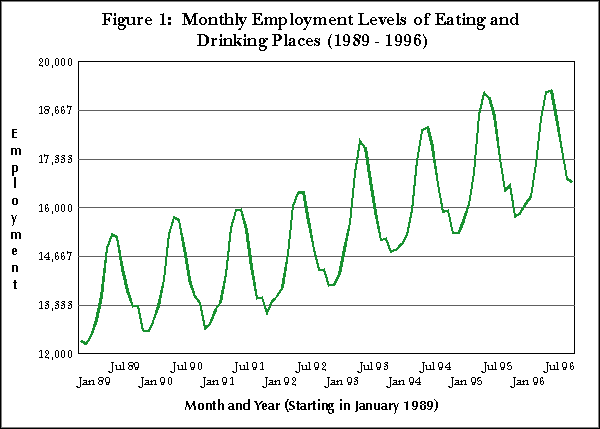
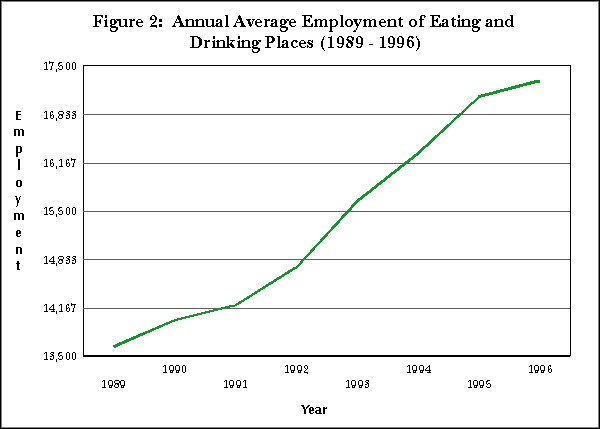
Figure 3, "Monthly Employment Levels of Wholesale Trade-Durable Goods," shows no visible trend in employment levels. The number of people employed in this industry has--in general--increased over time, but predictions of the future in this industry are more difficult than with Eating and Drinking Places. In Figure 1, it can be said that employment will go up in June and down in December, whereas in Figure 3, it cannot.
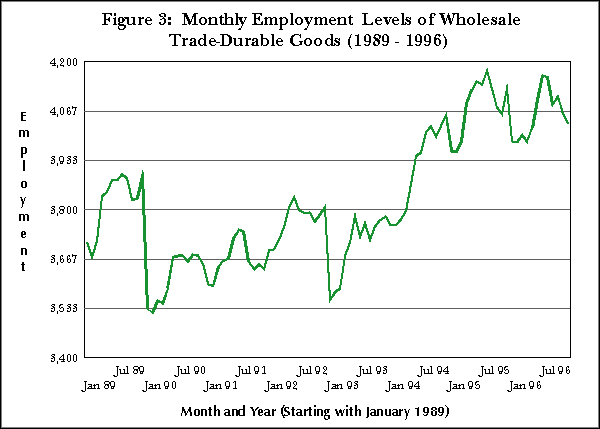 When general trends are observable, it is easy to see how predictions are made. Where there are no observable trends, other factors that might influence employment levels need to be researched, such as population. Population does not seem to affect how many people are employed in Wholesale or Retail Trade, but it may affect the amount of retail sales tax collections for each county. Retail sales tax collections show the consumption of goods by consumers.
There is only one major difference between Figure 4, "Population Estimates by County," and Figure 5, "Retail Sales Tax Collections by County." Teton County shows a low population but a high retail sales tax collection rate. In all other counties, there appears to be a close relationship between how many people are in a county and how much retail sales tax is collected. The high retail sales tax collections in Teton County may have to do with the increased tourist trade. Eating and Drinking Places are the highest sources of sales tax collections there whereas in most of the other counties, Food Stores have the highest sales tax collections.
When general trends are observable, it is easy to see how predictions are made. Where there are no observable trends, other factors that might influence employment levels need to be researched, such as population. Population does not seem to affect how many people are employed in Wholesale or Retail Trade, but it may affect the amount of retail sales tax collections for each county. Retail sales tax collections show the consumption of goods by consumers.
There is only one major difference between Figure 4, "Population Estimates by County," and Figure 5, "Retail Sales Tax Collections by County." Teton County shows a low population but a high retail sales tax collection rate. In all other counties, there appears to be a close relationship between how many people are in a county and how much retail sales tax is collected. The high retail sales tax collections in Teton County may have to do with the increased tourist trade. Eating and Drinking Places are the highest sources of sales tax collections there whereas in most of the other counties, Food Stores have the highest sales tax collections.
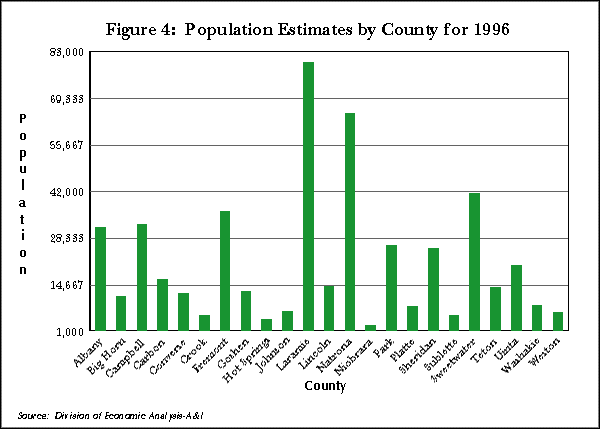
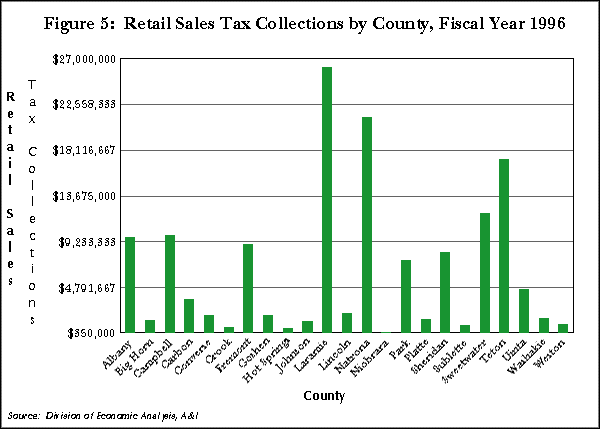
Figure 6, "Per Capita Income by County (1989 - 1994)," shows that Teton County also has the highest per capita income of any county in Wyoming. Per capita income is composed of earnings, interest, dividends and rental income. The statistical mean is derived from an area’s total income divided by the population. Since it appears that Teton County has a smaller population than eleven other counties, what could account for Teton County’s per capita income? Since this mean is the highest in the state, a segment of the total population in Teton County has a higher per capita income than the rest of the population in Wyoming. Teton County also has a higher retail sales tax collection than the two most populous counties. This reflects not only the higher per capita income in Teton County but also the large amount of visitors to this area.
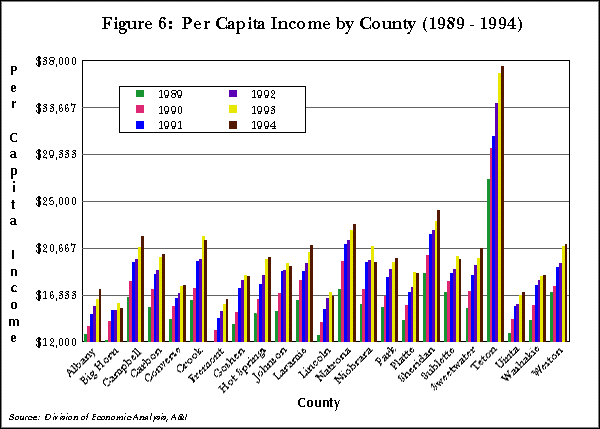 In Figure 7, "Average Annual Wages by County (1989 - 1995)," Teton County does not have a disproportionately high wage compared to the rest of the state; it is only slightly over $21,500 per year. This is due to the large amount of workers who are self-employed (and therefore not included in nonagricultural wage and salary employment) and those that have a higher dividend, pension, profit-sharing, interest, and rental income (per capita income). In comparing Figure 8, "Average Annual Employment in Wholesale and Retail Trade by County for 1996," and Figure 9, "Average Annual Wages in Wholesale and Retail Trade by County for 1996," it appears that the greater proportion of employees, those in Retail Trade, make the least amount of wages. Just the opposite is true for Wholesale Trade employees, because the least amount of employees make the most amount of wages.
In Figure 7, "Average Annual Wages by County (1989 - 1995)," Teton County does not have a disproportionately high wage compared to the rest of the state; it is only slightly over $21,500 per year. This is due to the large amount of workers who are self-employed (and therefore not included in nonagricultural wage and salary employment) and those that have a higher dividend, pension, profit-sharing, interest, and rental income (per capita income). In comparing Figure 8, "Average Annual Employment in Wholesale and Retail Trade by County for 1996," and Figure 9, "Average Annual Wages in Wholesale and Retail Trade by County for 1996," it appears that the greater proportion of employees, those in Retail Trade, make the least amount of wages. Just the opposite is true for Wholesale Trade employees, because the least amount of employees make the most amount of wages.
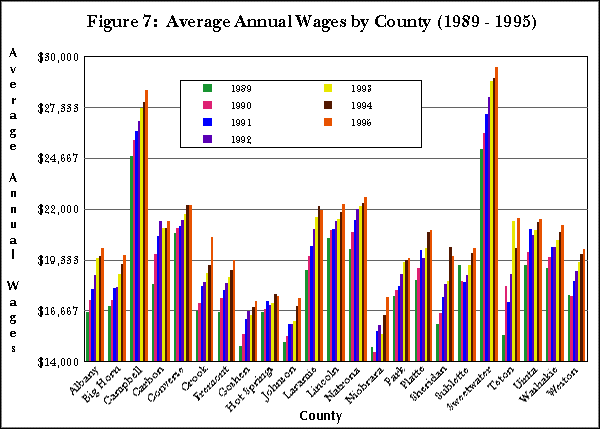

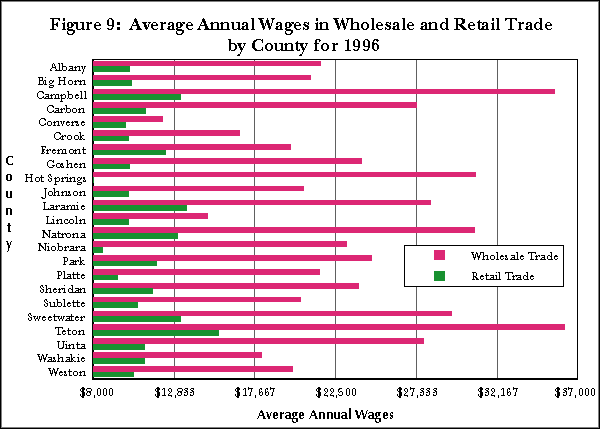
The examination of these figures shows us that a variety of data needs to be investigated in order to see a trend in the Wholesale and Retail Trade industries. The observed trend may then be used to assist in making predictions on what might happen to these industries in the future.
Valerie A. Davis is a Senior Statistician, specializing in Occupational Employment Statistics (OES) with Research & Planning. She is also an Associate Editor of
Wyoming Labor Force Trends.
This article was published in the Wyoming Labor Force Trends February 1998 issue.
|
|










